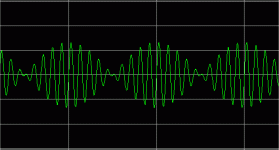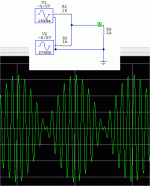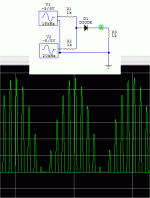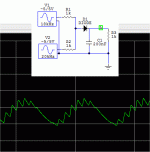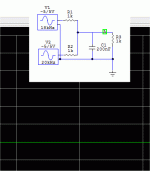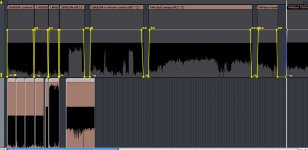Art
Air is always nonlinear, its not like all of a sudden it gets nonlinear. I have a strong suspicion that the nonlinearity is far greater at VHF than it is at lower frequencies. So 104 dB may well be sufficiently nonlinear.
The bottom line here is that there IS a nonlinearity somewhere - you tell us where it is. Otherwise your test is not as good as you are thinking it is because it is doing things that you can't explain.
I am all for accuracy as well, but if you cannot rank order effects but instead go after everything then you are not doing good engineering.
Air is always nonlinear, its not like all of a sudden it gets nonlinear. I have a strong suspicion that the nonlinearity is far greater at VHF than it is at lower frequencies. So 104 dB may well be sufficiently nonlinear.
The bottom line here is that there IS a nonlinearity somewhere - you tell us where it is. Otherwise your test is not as good as you are thinking it is because it is doing things that you can't explain.
I am all for accuracy as well, but if you cannot rank order effects but instead go after everything then you are not doing good engineering.
Hmmm... you've lost me here. It's being claimed that a 2K "tone" does not exist in Art's test unless the system is non-linear. It's just an "envelope". Yet it shows up at the microphone.
How does the mic detect this envelope if it does not exist in the way that the 18K and 20K tones do? What I mean is; is there compression and rarefaction of the air molecules at 2Khz? (about 17cm) If not, how does the envelope exist? Isn't it a variation in amplitude?
How does the mic detect this envelope if it does not exist in the way that the 18K and 20K tones do? What I mean is; is there compression and rarefaction of the air molecules at 2Khz? (about 17cm) If not, how does the envelope exist? Isn't it a variation in amplitude?
True.A "tone" is a real signal, a beat is an envelope modulation. It really is important to understand the difference here. It is not just semantic.
And in Dave's example of 440 and 441, you don't hear a separate 1Hz tone, you hear the A note waver at one cycle per second. This is how I tune my guitar - get it close, then, picking the same harmonic on two adjacent strings, tune one string up until the beat goes away. Pianos have three strings per key, each tuned slightly off to produce a tremolo effect.
It's being claimed that a 2K "tone" does not exist in Art's test unless the system is non-linear.
One way to perceive this is to look at the envelope. In a typical signal such as a sinewave, the amplitude varies from positive to negative, as does the high frequency content here. In the case of the 2kHz content it contains, there is an equal and opposite component above/below the 0V line and hence a nett zero effect at that frequency.
In order then to uncover the 2kHz content, it has to be 'nudged off-centre'. As with 'detecting' or de-modulating an AM signal, a non-linear element is used, and originally diodes were used for this purpose.
Attachments
Just for illustration (I'm having a slow afternoon 🙂)
1. Mixing 18/20kHz
2. 'Unbalancing' it.
3. Filtering the 18/20kHz reveals the 2kHz.
4. Filtering the 18/20kHz before adding the non-linear element would cause the signal to be lost.
1. Mixing 18/20kHz
2. 'Unbalancing' it.
3. Filtering the 18/20kHz reveals the 2kHz.
4. Filtering the 18/20kHz before adding the non-linear element would cause the signal to be lost.
Attachments
Last edited:
True.
And in Dave's example of 440 and 441, you don't hear a separate 1Hz tone, you hear the A note waver at one cycle per second. This is how I tune my guitar - get it close, then, picking the same harmonic on two adjacent strings, tune one string up until the beat goes away. Pianos have three strings per key, each tuned slightly off to produce a tremolo effect.
All true except for the piano comment. The three strings are tuned to be beatless. An interesting study some time back showed that once you got the "unisons" close enough they would phase lock to each other. The end points are not absolutely stationary and one string will drive the next.
David
Just for illustration (I'm having a slow afternoon 🙂)
1. Mixing 18/20kHz
2. 'Unbalancing' it.
3. Filtering the 18/20kHz reveals the 2kHz.
4. Filtering the 18/20kHz before adding the non-linear element would cause the signal to be lost.
Ooh, AM detectors! Way better than that upstart FM.
Classic AM is double sideband, meaning that 1kHz audio on the back of a 1mHz carrier requires the upper and lower sidebands of 999kHz and 1001kHz. Using both sidebands lets you actually see the modulation as the envelope of the HF carrier and also lets simple detectors, like your example, give low distortion.
Germain to our discussion, the modulation envelope of AM is only showing beats. No 1kHz "baseband" material is included. If it were it wouldn't make it through the transmitting process, or the receiver. We want the modulation to be tightly clustered around the carrier, so that it can make it through the input filtering of the radio, be mixed down to the 455kHz if (intermediate frequency amplifiers), and finally, in the nonlinear elements of the detector, be detected down to the original audio frequencies.
A useful example of nonlinearity creating subharmonics.
David S
Hmmm... you've lost me here. It's being claimed that a 2K "tone" does not exist in Art's test unless the system is non-linear. It's just an "envelope". Yet it shows up at the microphone.
Because it shows up at the mic, it must be a real tone and not a beat. For it to be a real tone the system must be nonlinear somewhere. If the system were perfectly linear then there could not be a tone at 2 kHz. I don't know precisely where the nonlinearity is at, thats why I suggested that Art should try and find it. You cannot do a test on the audibility of something like these VHF tones unless you can null out this kind of problematic nuisance variable. Otherwise the test results are all suspect.
A useful example of nonlinearity creating subharmonics.
David S
Not to be argumentative, but this statement is slightly in error - a very common error and thats why I bring it up.
In theory nonlinearities connot create subharmonics (I'll get back to this point later). They can create frequencies below the signal frequencies but these are sum and difference tones of complex signls, not harmonics. A sub harmonic implies a single tone and the existance of tones at integer fractions of the fundamental. In the theory of nonlinear time-invarient systems this cannot occur.
Now, I have personally seen subharmonics in data before so I too had doubted this. So I personally talked with Martin Schetzen who is probably the worlds leading authority on nonlinear systems. I had read his excellent book and as far as I am concerned if he says it, it is a fact. He said that for a subharmonic to exist the system could not be time-invarient. Basically the system parameters are changing in time as well as with amplitude - the system is not time invarient and it is the relationship between the time variance of the parameters and the nonlinearity of them (remember time is the independent variable in a Diff-Eq and and the parameters are assumed constant in this variable. In a nonlinear system the parameters can vary with the dependent variable, usually dispacement, but are usually assumed to not vary in time.)
In looking back at the data that I had I could see how the thermal changes in the voice coil would happen in time and hence the system was not time-invarient and that was why there were sub-harmonics. It was this precise realization that lead me to think about and study voice coil heating and why I now firmly believe that the signal is modulated by this heating creating "sub-band" signals which are very un-musical. This, I believe, is what people call "dynamics".
I have a plan in place to test this hypothesis. Hopefully sometime in the next year.
I have a strong suspicion that the nonlinearity is far greater at VHF than it is at lower frequencies.
On this, I'm in complete agreement.
It shows up at the output of the microphone, it doesn't necessarily exist at the input of the microphone. More than one participant in the thread seems to be making the assumption that the microphone itself is not introducing any non-linearity.Hmmm... you've lost me here. It's being claimed that a 2K "tone" does not exist in Art's test unless the system is non-linear. It's just an "envelope". Yet it shows up at the microphone.
Just how linear is a microphone at 105dB at high frequencies, even a measurement grade microphone ? Much more linear than typical speakers I'm sure, but probably not distortion free.
Using a separate driver to produce each tone pretty much rules out the drivers as the source of non-linearity when looking for difference frequencies, leaving non-linearity in (a) the air itself, (b) the microphone (c) the microphone pre-amp and/or ADC stages.
When a microphone is measuring multiple tones produced by the same driver its probably fair to say that unless the microphone is being overdriven that the distortion products of the speaker (including the difference tone) will dwarf any distortion added by the microphone, allowing us to ignore it.
But in the special case where you have two closely spaced high frequency tones each produced by their own driver, that source of distortion is gone, so distortion in the microphone and mic pre-amp may now come to the fore.
My money would be on the microphone and/or the microphone pre-amp as the source of a small but non-zero amount of difference tone being measured at 2Khz. (Has anyone calculated the amount of distortion necessary to account for the measured difference product ?)
Earl made a good point - the source of the non-linearity needs to be identified to go any further. If there isn't any non-linearity there would be no measurable amount of 2Khz, and it's useless debating something as fundamental and incontrovertible as that...
Last edited:
Earl,Because it shows up at the mic, it must be a real tone and not a beat. For it to be a real tone the system must be nonlinear somewhere. If the system were perfectly linear then there could not be a tone at 2 kHz. I don't know precisely where the nonlinearity is at, thats why I suggested that Art should try and find it. .
As we know, loudspeakers systems, the air they broadcast through, and our hearing are not perfectly linear.
Other than the RTA, magnitude and phase charts afforded by Smaart, and my ear/meat computer interface, I have no other tools at my disposal to determine precisely where the non-linearity that creates the beat tone lies in the multiplicity of non-linearity.
We can clearly see the non-linearity causing the audible sub harmonic beat tones do not appear to be in the electronic or transducer end of the equation.
Since sub harmonic beat tones can be heard from unamplified acoustic sources such as stringed instruments, horns, cymbals and any number of other sources, the fact that a pair of horns driven well below their output potential can also create real tones at the beat frequencies does not inspire me to search out the precise cause of something I have no tools to measure.
If you are interested in finding the precise cause, go for it, I will offer my assistance in your quest if possible.
As it stands, my experiment proposed 4/22/12 in post # 136 to determine whether the beat frequencies from two ultrasonic tones reproduced by two standard speakers used as discreet sources with no measurable sub harmonic present in either actually creates an audible beat frequency proved to be no “canard”.
The fact that the sub harmonic tone from discreet, low distortion ultrasonic sources is audible, measurable, and recordable does reinforce my previously stated position that clean extended HF above audibility can still benefit those of us with hearing incapable of hearing the extended HF directly.
Art
If you aren't sure where the nonlinearity comes from here are a few thoughts: If you suspect the microphone, then moving to twice the distance would drop the levels by 6dB. If the distortion products drop by 6dB, then the mic is clear. If they drop more than 6, suspect the mic.
If you think it is due to the air, it sounds like you are feeding two drivers and the signal is mixing in the air? If so can you feed to two drivers while physically seperated? The signals will still mix in the air, but only after some travel and when the level has significantly dropped.
If the signals, on the other hand, both go to the same drivers, wouldn't we suspect IM in the drivers?
David S.
If you think it is due to the air, it sounds like you are feeding two drivers and the signal is mixing in the air? If so can you feed to two drivers while physically seperated? The signals will still mix in the air, but only after some travel and when the level has significantly dropped.
If the signals, on the other hand, both go to the same drivers, wouldn't we suspect IM in the drivers?
David S.
Not to be argumentative, but this statement is slightly in error - a very common error and thats why I bring it up.
In theory nonlinearities connot create subharmonics (I'll get back to this point later). They can create frequencies below the signal frequencies but these are sum and difference tones of complex signls, not harmonics. A sub harmonic implies a single tone and the existance of tones at integer fractions of the fundamental. In the theory of nonlinear time-invarient systems this cannot occur.
Guilty...of sloppy terminology.
I have seen true subharmonics in woofers before, both in cone cry, which is a horrendous sound where the cone breaks into a true half frequency output. The input signal becomes the 2nd harmonic to the cone cry and the distortion percentage is huge.
I have also seen woofers at low frequencies and high drive where they pop out of the gap to the point where they just miss a cycle before falling back in. This forces them into a sustained oscillation at half the input frequency.
Very interesting when you see it.
David
The microphone can be ruled out, as it clearly shows the subharmonic distortion in a single driver when the same level 18 and 20 kHz tones are played through it.It shows up at the output of the microphone, it doesn't necessarily exist at the input of the microphone. More than one participant in the thread seems to be making the assumption that the microphone itself is not introducing any non-linearity.
Just how linear is a microphone at 105dB at high frequencies, even a measurement grade microphone ? Much more linear than typical speakers I'm sure, but probably not distortion free.
Using a separate driver to produce each tone pretty much rules out the drivers as the source of non-linearity when looking for difference frequencies, leaving non-linearity in (a) the air itself, (b) the microphone (c) the microphone pre-amp and/or ADC stages.
When a microphone is measuring multiple tones produced by the same driver its probably fair to say that unless the microphone is being overdriven that the distortion products of the speaker (including the difference tone) will dwarf any distortion added by the microphone, allowing us to ignore it.
But in the special case where you have two closely spaced high frequency tones each produced by their own driver, that source of distortion is gone, so distortion in the microphone and mic pre-amp may now come to the fore.
My money would be on the microphone and/or the microphone pre-amp as the source of a small but non-zero amount of difference tone being measured at 2Khz. (Has anyone calculated the amount of distortion necessary to account for the measured difference product ?)
Earl made a good point - the source of the non-linearity needs to be identified to go any further. If there isn't any non-linearity there would be no measurable amount of 2Khz, and it's useless debating something as fundamental and incontrovertible as that...
When a single tone is played through the driver, the subharmonic distortion drops to the noise threshold.
Though the microphone must contribute some distortion, at < 1% Diff. freq. distortion at 153 dB, it’s distortion contribution at 105 dB is negligible .
The actual microphone chart is attached.
The 2000 Hz subharmonic generated by the discreet drivers with 18 and 20 kHz tones was -32.4 from the fundamental, about 3% distortion.
The subharmonic tone generated in a single driver was -56.4 dB, less than .02% distortion.
The sum of two different signal powers is roughly + 3 dB if the two powers are equal, the single driver had far less distortion with double the power each of the single tone drivers received creating the louder sub harmonic tone.
Since the DSP/amplifier/driver/microphone chain has distortion far below the audible beat frequency tone made by the two driver combination, the logical assumption is the only other component left, air, is the non-linear “smoking gun” responsible for the audibility of the sub-harmonic beat tones.
Art
Attachments
David,If you think it is due to the air, it sounds like you are feeding two drivers and the signal is mixing in the air? If so can you feed to two drivers while physically seperated? The signals will still mix in the air, but only after some travel and when the level has significantly dropped.
If the signals, on the other hand, both go to the same drivers, wouldn't we suspect IM in the drivers?
David S.
Mic is clear, see my previous post.
IM was measured in a single driver and posted previously.
The two drivers were physically separated, each with a discreet tone, the output mixed in the air.
If the test was done at a greater distance, more power would need to be applied to the drivers to make the sub harmonic tone visible on the RTA screen.
Have you listened to the recordings yet?
Hey Art - the preamp could still be the cause, but that should be easy to test.
If you feed the mic preamp the 2 tones from a balanced, mic level source, you should be able to tell. You'd want the gain set about the same, if you remember what it was, so that the signal coming in is the same as the mic was supplying.
Should be a quick test, if you can get the test tones about at mic level.
If you feed the mic preamp the 2 tones from a balanced, mic level source, you should be able to tell. You'd want the gain set about the same, if you remember what it was, so that the signal coming in is the same as the mic was supplying.
Should be a quick test, if you can get the test tones about at mic level.
I don't see how this rules out the microphone ?The microphone can be ruled out, as it clearly shows the subharmonic distortion in a single driver when the same level 18 and 20 kHz tones are played through it.
Something very very wrong with the test setup if a single driver producing the two tones is producing .02% IM distortion and two separate (identical?) drivers each producing only one of the tones is generating a massive 3% IM distortion.When a single tone is played through the driver, the subharmonic distortion drops to the noise threshold.
[...]
The 2000 Hz subharmonic generated by the discreet drivers with 18 and 20 kHz tones was -32.4 from the fundamental, about 3% distortion.
The subharmonic tone generated in a single driver was -56.4 dB, less than .02% distortion.
The sum of two different signal powers is roughly + 3 dB if the two powers are equal, the single driver had far less distortion with double the power each of the single tone drivers received creating the louder sub harmonic tone.
Alarm bells should be ringing when you're getting back to front results like that... 😉
I think if air by itself was able to generate 3% IM distortion at 105dB SPL we would have heard about it by now... 😱Since the DSP/amplifier/driver/microphone chain has distortion far below the audible beat frequency tone made by the two driver combination, the logical assumption is the only other component left, air, is the non-linear “smoking gun” responsible for the audibility of the sub-harmonic beat tones.
Sorry, but I really think there must be something wrong with your test setup or measurements.
The 130 volt B&K power supply/preamp uses a modified ( two pins removed) 5 pin XLR input. Not very easy to do what you suggest, and with my luck I'd wreck something in the process, and I don't want to do that.Hey Art - the preamp could still be the cause, but that should be easy to test.
If you feed the mic preamp the 2 tones from a balanced, mic level source, you should be able to tell. You'd want the gain set about the same, if you remember what it was, so that the signal coming in is the same as the mic was supplying.
Should be a quick test, if you can get the test tones about at mic level.
At any rate, if any part of the electronics were contributing distortion, they are part of the visible noise floor posted previously. The electronics distortion component is simply too low to cause any distortion remotely like the audible difference tone, which sounded live just like the microphone recording to me.
Actually, the microphone is far more sensitive than my poor old ears, I initially started the test with a 16 and 20 kHz tone, which results in a 4 kHz tone, clearly visible on the RTA, but right in the middle of my NIHL hole.
I could hear the beat frequency tones down to 100 Hz, and up to about 12K, but not 4K, which is why I chose to post the 18 and 20K combo, I hate to mix something I can barely hear..🙁.
NIHL sucks, a little too low level and I can't hear properly, too loud and my ears distort. It does tend to keep my mixes "in the pocket".
By the way, there are several other recordings of the two drivers, screen shot attached if any one has special requests.
Which reminds me, I still have not finished mixing the music played through the various compression drivers. Because of the limited file size we can post, I have to choose what 10 second portion of a 30 second music excerpt to use, which is a shame, each part of the song reveal different distortion qualities at different SPL levels.
Attachments
The air by itself does not generate 3% IM distortion, it makes the output difference tone between two loud drivers audible.I think if air by itself was able to generate 3% IM distortion at 105dB SPL we would have heard about it by now... 😱
Sorry, but I really think there must be something wrong with your test setup or measurements.
As Pano's "how much power do your speakers use" test reveals, most respondents only listen at around 80 dB or so.
If the level of the drivers was reduced by 24 dB, the sub harmonic tone could only be heard by folks with very sensitive hearing, such as yourself.
It would also have been too low to show up above the noise floor.
At any rate, you can easily duplicate the test yourself if you doubt the results.
To duplicate the results requires tweeters that can reproduce ultrasonic tones.
My test mic was only 22.5 inches from the horn mouths, if you cut that distance in half the HF drivers would only need to produce 98 dB to achieve the same results.
Conversely, at a normal listening distance, the level would need to be much louder.
The Maltese horns used are super narrow dispersion, it would be interesting to hear the results from some tiny wide dispersion tweeters.
Art
Last edited:
- Status
- Not open for further replies.
- Home
- Loudspeakers
- Multi-Way
- What are benefits of adding HF driver 7khz up?
